Pulau Serangan: A case example of current coral mariculture practices in Indonesia
Pulau Serangan, Bali, Indonesia
From August 2006, until March 2007, I lived and worked in Bali, Indonesia as an intern for the Marine Aquarium Council (MAC). The principle purpose of my work was to write a simple, easy to understand coral mariculture manual useful for local Indonesians engaging in this relatively new alternative to wild coral harvest. I studied a number of coral mariculture (lagoon-based) operations throughout Indonesia. They ran the gamut from being very carefully managed and profitable, to downright damaging to the adjacent reef. Overall, I believe that the benefits outweigh the negatives. I believe that over time, and with better education and understanding, the overall quality will improve. With the right management and oversight, coral mariculture will continue to emerge as an environmentally and economically sustainable practice accessible to coral exporting countries.

Typical coral mariculture tables found at Pulau Serangan
Here I briefly highlight the coral mariculture activities in a bay in the south-eastern tip of Bali on a small island called Pulau Serangan (Turtle Island). The area seems particularly well suited to coral mariculture since the natural reef was (unfortunately) destroyed by human development. However, the water quality remains pristine enough to promote stony coral growth.

Bali via Google Earth. Pulau Serangan is indicated by the push-pin icon.

A closer view from space of Pulau Serangan via Google Earth. The densely populated Urban centers of Denpasar and Kuta are located just to the North and West.
Originally, the waters surrounding Pulau Serangan harbored a thriving natural reef which was an important source of fishes for marine ornamental collection. A marina was proposed for the area in the mid 1990’s and thus the filling, dredging, and reef destruction took place. The project was halted in 1998, thus allowing the current mariculture activities to become established without interfering with other uses of the area. Unfortunately for the future, a large-scale tourism development is once again being proposed for the surrounding land. If completed, this project will be certain to impact, and eventually close, the mariculture operations taking place.

A view from a coral mariculture site looking back towards the shore in the bay at Pulau Serangan.
The coral mariculture operations at Serangan are dense and extensive. A multitude of operations are all located in the close quarters of a small, sheltered bay. The dimensions of the bay are approximately 1500m long by 100 m wide, however the coral farming takes place in an area about 400 m long by 75 m wide. Much of the land around the area is ‘reclaimed’, having been formed from dredging and excavation of the surrounding waters, and from thousands of tons of coral limestone brought from elsewhere. The bay itself is framed by two manmade jetties, constructed of large rocks. The mid-section is a 150m long beach composed of grey-brown sand.
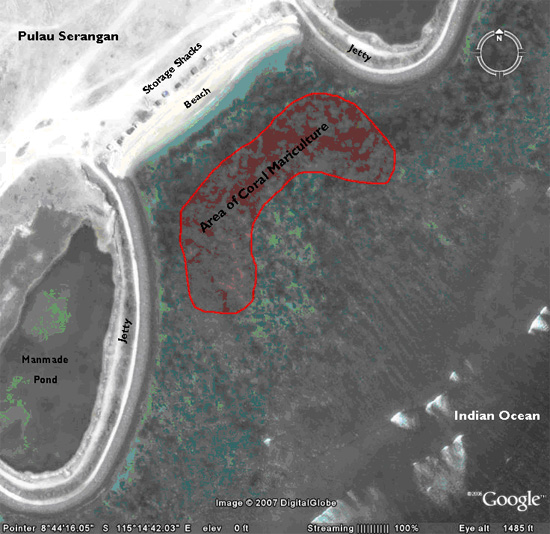
A satellite image of the bay at Pulau Serangan via Google Earth
Serangan seems to be an ideal place for coral aquaculture for several reasons. The bay is shallow and flat. The infrastructure development from years past has reduced the sea bottom to a wasteland of dead coral rubble (although most of the sizeable chunks of rubble have been removed by local people for building purposes). Sea grass and macro-algae cover extensive areas amidst this rubble.

Sand, coral rubble, seagrass, and algae dominate the seafloor in the bay at Pulau Serangan. Note the table frame constructed of rebar.
The geographical orientation puts the bay in direct contact to the open Indian Ocean; flushing it with cool water at every changing tide. This is an ideal situation for the corals’ protection during high-temperature bleaching events. The shallow, rocky reef along the mouth of the bay appears to prevent any heavy or potentially damaging storm-surge from disrupting the coral tables in normal conditions. The area gets flushed regularly with currents that bring fresh seawater from the depths beyond the bay, encouraging healthy stony coral growth. This steady water flow requires that tables be firmly anchored to the sea floor. The lack of natural coral cover and uniform bottom makes most of the entire area suitable for coral farming. The shallowness of the bay allows regular maintenance to be performed with mask and snorkel and/or by wading at low tide. At low tide the tops of the corals are only under 10-30 cm of water.

A worker performs regular maintenance on the coral mariculture tables in shallow water at Pulau Serangan
There are 12 separate operations taking place here, maintained by about 30 local people. Each of the operator’s areas is delineated by tall bamboo poles marked with identifying flags.
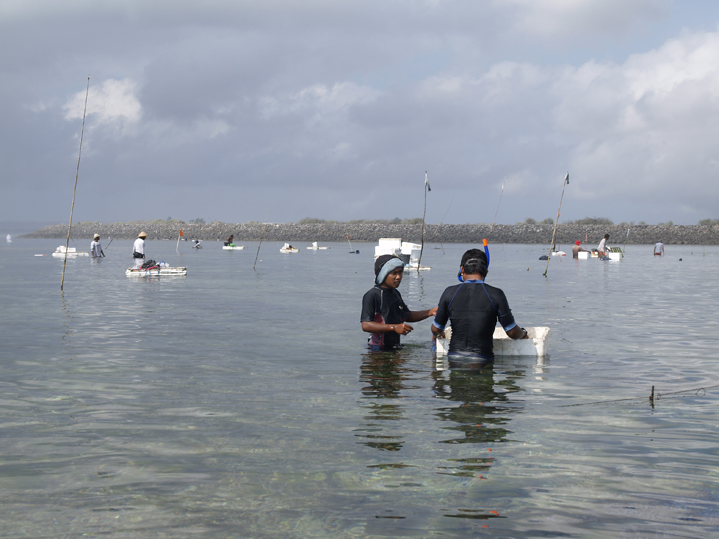
Serangan, Bali is a shallow water location that allows for easy maintenance and access to the corals. Note the marker flags delineating specific culture plots.
Each operation consists of 10 to 50 culturing tables. The quality of each operation varies greatly. Some sites have been obviously abandoned. These sites are characterized by unpruned tables of large corals that have grown intertwined with each other. The result is what appears to be beautiful, natural squares of reef. Apparently these operations initially invested heavily in growing coral species that ended up having a low market demand and value; therefore further culturing efforts were abandoned.
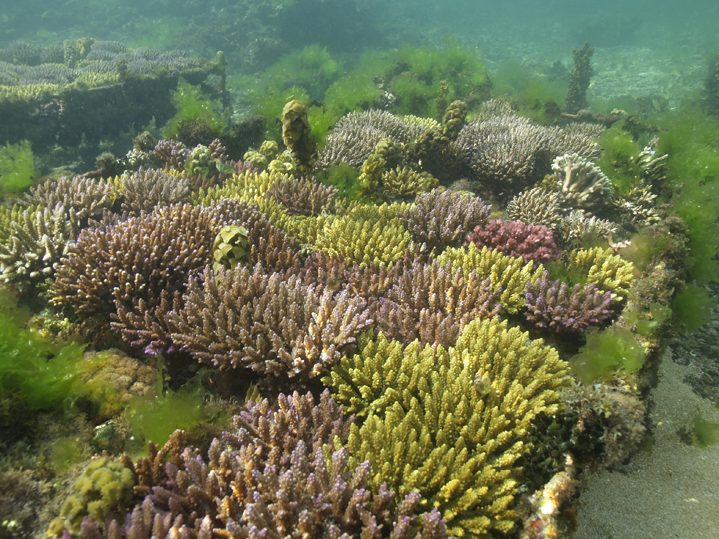
These tables have been abandoned and the corals have become overgrown and intertwined with each other. Corals such as these could still be used in coral rehabilitation projects.
Likewise, broken fragments, discarded, and dislodged corals have begun to grow into proper “wild coral” colonies in the areas between and around the tables.

Here a table has been abandoned and destroyed by the waves. It is possible that some of the corals will likely continue to grow, and repopulate the area if they aren’t deemed commercially viable.
Serangan is a good place to see a diverse collection of coral farming techniques. Some people use tables made entirely of bamboo, whose finite lifespan is demonstrated by a few splintered piles of decomposing wood. Others are made of professionally welded metal that appear to last for multiple years, despite being quite rusty. Most outfits attach the coral pugs to the tables using some sort of strapping system involving parallel rubber strips that allow for easy removal of the coral plugs for cleaning. One creative method of attachment involves placing a plastic bottle cap into the cement base and then screwing it onto cement-filled plastic bottle tops that are attached to the tables. Another popular method employs plugs with a 10-14 cm long cement cone beneath the base that fit into specifically designed slots on the tables. The common theme to the choice of plug attachment at Serangan is easy accessibility for removal and cleaning. The majority of corals here are attached to the cement plugs with a locally available two-part autobody filler cement.
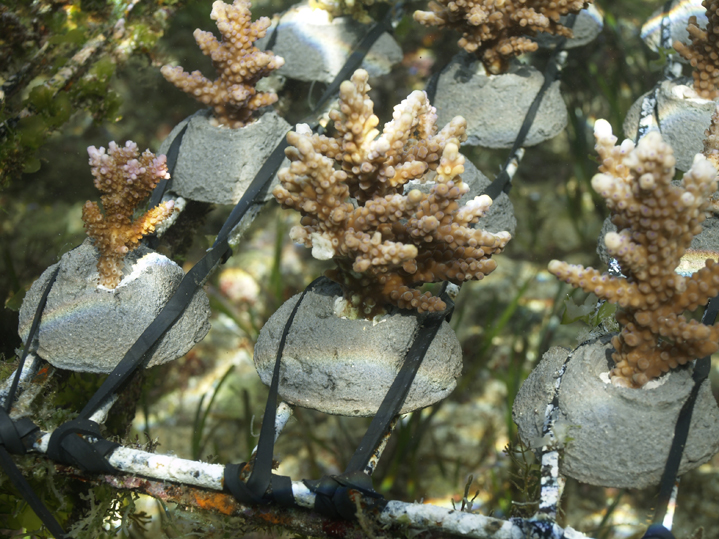
These newly fragged corals are held in place by long rubber bands, which allows for relatively easy removal for maintenance purposes.
Most of the corals that are cultured here are stony and branching; with the majority of these being Acropora spp. The shallow, clear, well circulated water makes this site an ideal environment for these species. The close proximity of the site to the export facilities in Denpasar (5-10km) is also helpful in reducing transport stress on the newly harvested corals.
The major drawback to coral farming on Serangan is the large amount of labor required to keep the tables and corals free from algae. It appears that Serangan suffers from periodic algal blooms of differing algae species throughout the year. The algae are most likely fueled by nutrients leached from the area’s close proximity to a large landfill and densely populated areas of south-east Bali. Consequently, tables must be regularly scrubbed clean to remove the encroaching algae. Corals that are not regularly cleaned suffer from these competing algae.
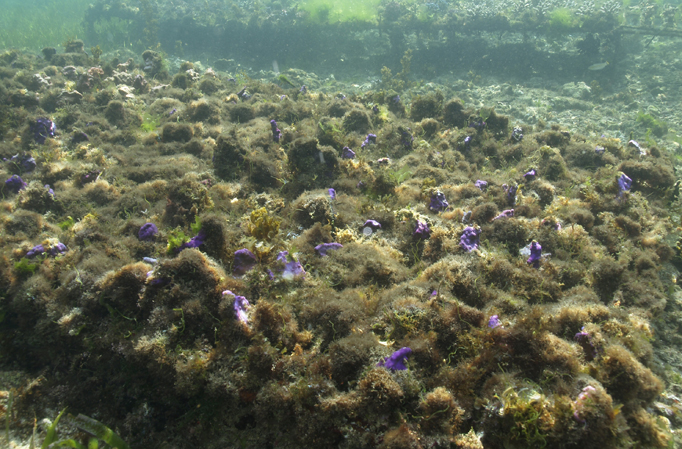
This table has clearly been neglected and has become overgrown with algae.
Quite often the algae will kill off the living coral tissue where it attaches to the plug. Once the alga has a foothold on the coral skeleton, it can continue its creep upwards towards the branches. A species of alga, Ostreobium sp. seem to infect the skeleton itself, moving upwards, killing the coral from the inside out. Feedback from aquarists and retailers corroborates that some maricultured corals seem to waste away from the bottom up, and post-mortem examination of the cleaved skeleton reveals the green tinge characteristic of this algal infection. To prevent mortality amongst newly arrived maricultured corals, many retailers will break off the base and reattach the coral to new substrate. One supplier estimates that for each table at Serangan, an hour of labor per week is required to keep it clean. A significant challenge here is recruiting and training local people to carry out routine cleaning operations without the need for constant supervision.

Another issue with the high density of different coral farming operations at Serangan is theft of corals; especially mother stock. This issue is exacerbated when a farmer goes to great lengths to find an unusual coral species or morph and brings it back to Serangan to grow out. However, it appears that theft is not a rampant issue, but it is certainly an annoyance, especially for the more established and professional operations that appear to be the target.
Attributes of Serangan as a coral mariculture site:
– The bay is shallow and sheltered from severe water currents and large waves.
– The seafloor is flat with scattered rubble and patchy seagrass.
– In the years prior to failed development projects, the waters adjacent to Serangan supported healthy corals.
– Freshwater input is very low.
– Human habitation and use of the immediate surrounding area is low.
– The shallow, rocky reef along the mouth of the bay prevents most heavy or potentially damaging storm surge from disrupting the coral tables.
– Direct connection to the open Indian Ocean flushes the bay with cool water.
– The lack of natural coral cover and uniform bottom makes nearly the entire area suitable for farming.
– The shallowness allows regular maintenance to be performed with mask and snorkel and/or by wading at low tide.
– Serangan is strategically located close to export facilities and the international airport.
Drawbacks of Serangan as a coral mariculture site:
– Serangan suffers from periodic algal blooms of differing algae species throughout the year.
– Serangan is located closely to a large landfill and densely populated areas (e.g. Kuta, Denpasar) of south-east Bali.
– A large amount of labor is required to keep the tables and corals free from algae.
– Multiple operations must share a small area for mariculture.
– Theft is a minor, and occasionally problematic, issue.
– The area is in legal limbo, which makes it unlikely that coral mariculture will be able to continue if, and when, a new development is proposed for the surrounding land.
